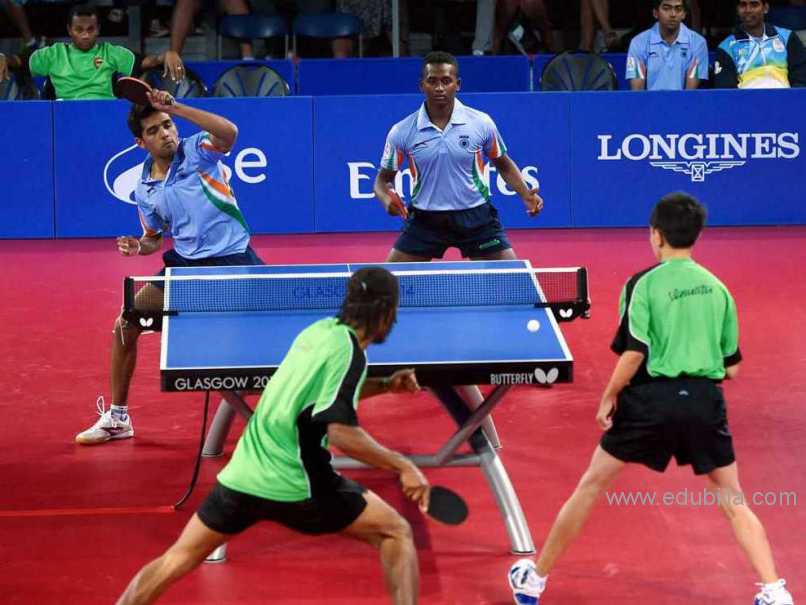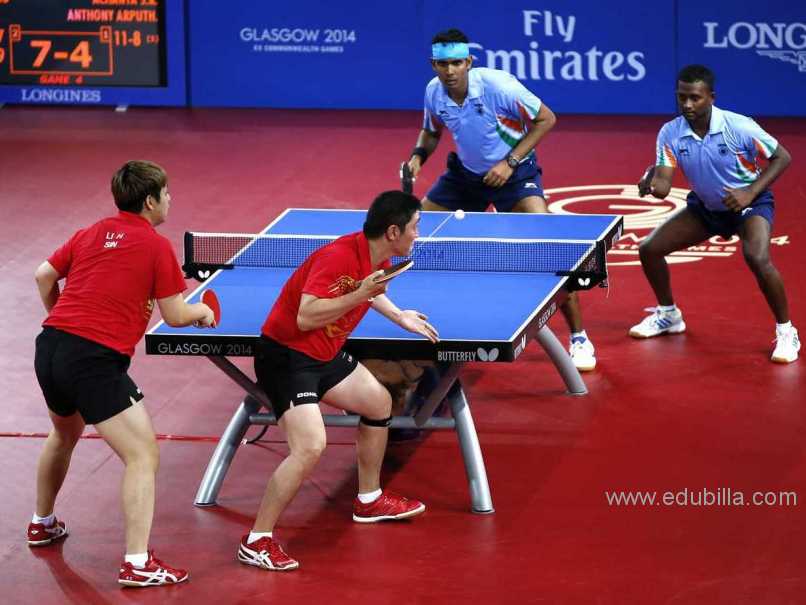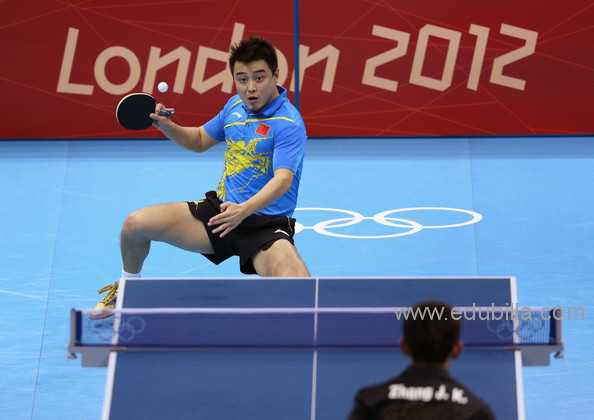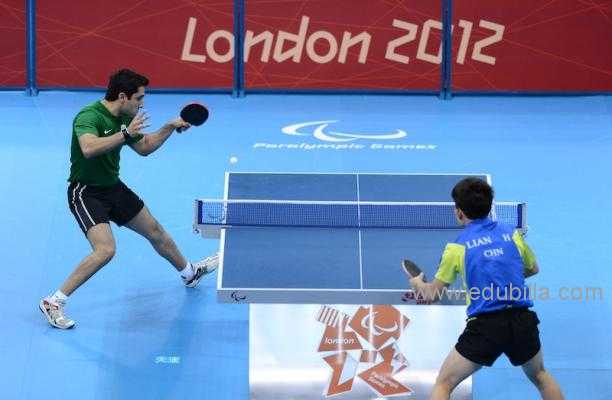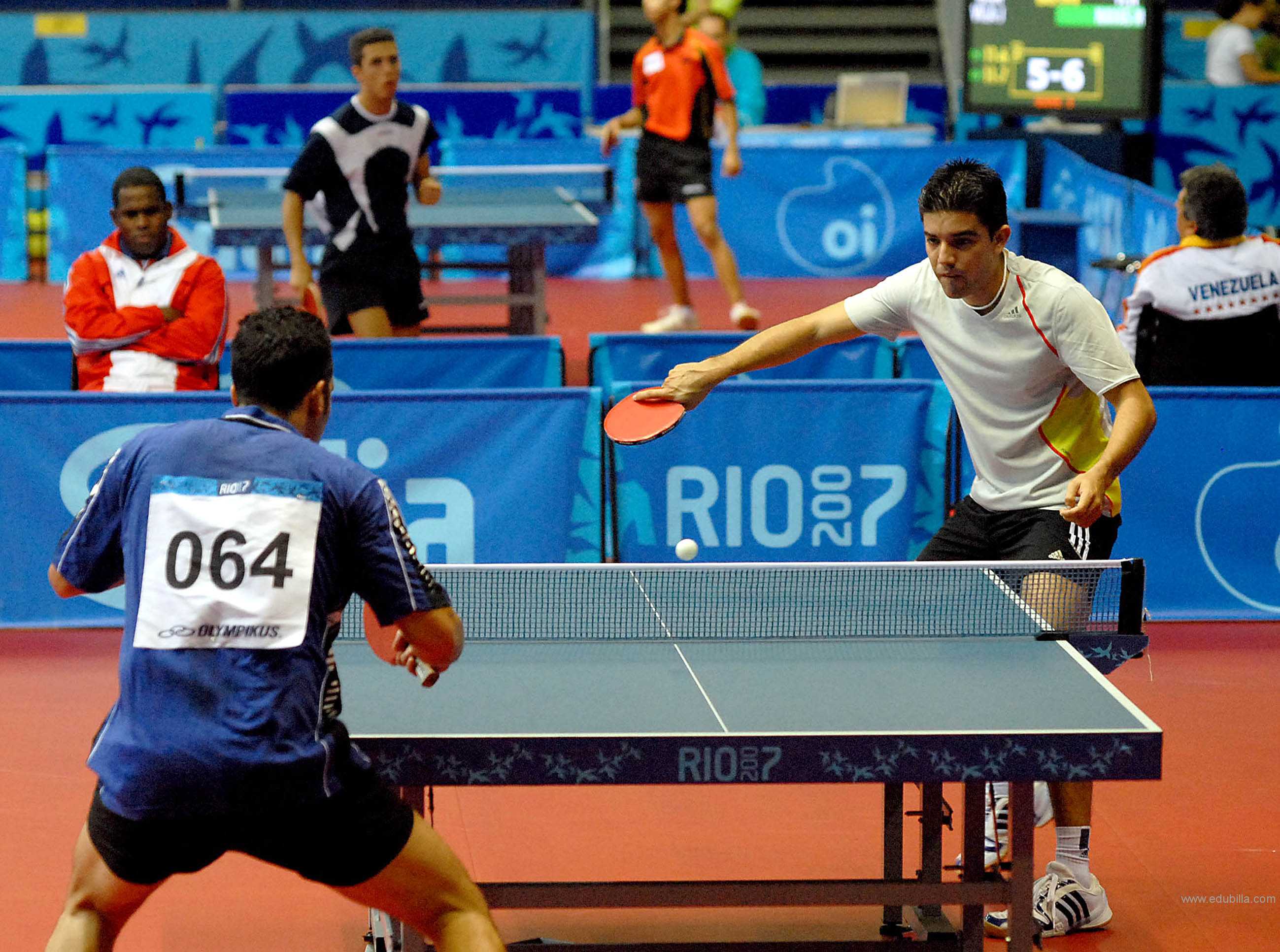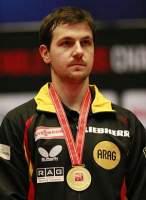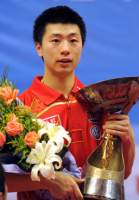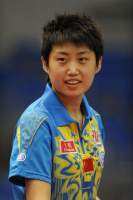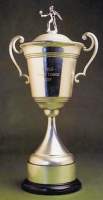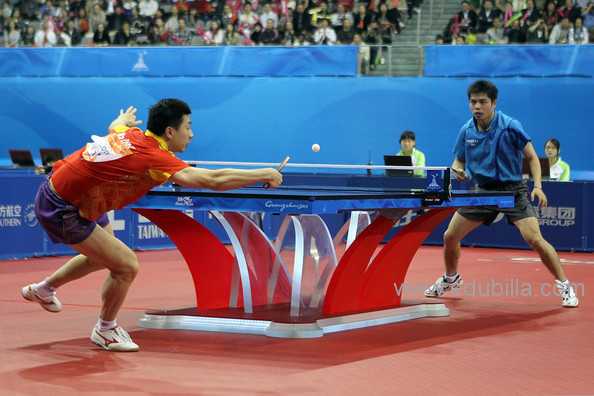
Overview Of Table Tennis
Table tennis (also called ping pong) is a sport in which two or four players hit a lightweight ball back and forth using a table tennis bat. The game takes place on a hard table divided by a net. Except for the initial serve, players must allow a ball played toward them only one bounce on their side of the table and must return it so that it bounces on the opposite side. Points are scored when a player fails to return the ball within the rules. Play is fast and demands quick reactions. Spinning the ball alters its trajectory and limits an opponent's options, giving the hitter a great advantage. When doing so the hitter has a good chance of scoring if the spin is successful.
Table tennis is governed by the worldwide organization International Table Tennis Federation, founded in 1926. ITTF currently includes 220 member associations.The table tennis official rules are specified in the ITTF handbook.Table tennis has been an Olympic sport since 1988,with several event categories. In particular, from 1988 until 2004, these were: men's singles, women's singles, men's doubles and women's doubles. Since 2008, a team event has been played instead of the doubles.
Game Rules
THE TABLE:
1)The upper surface of the table, known as the playing surface, shall be rectangular, 2.74m long and 1.525m wide, and shall lie in a horizontal plane 76cm above the floor.
2)The playing surface shall not include the vertical sides of the tabletop.
3 )The playing surface may be of any material and shall yield a uniform bounce of about 23cm when a standard ball is dropped on to it from a height of 30cm.
4)The playing surface shall be uniformly dark coloured and matt, but with a white side line, 2cm wide, along each 2.74m edge and a white end line, 2cm wide, along each 1.525m edge.
5)The playing surface shall be divided into 2 equal courts by a vertical net running parallel with the end lines, and shall be continuous over the whole area of each court.
6)For doubles, each court shall be divided into 2 equal half-courts by a white centre line, 3mm wide, running parallel with the side lines; the centre line shall be regarded as part of each right half-court.
THE NET ASSEMBLY:
1)The net assembly shall consist of the net, its suspension and the supporting posts, including the clamps attaching them to the table.
2)The net shall be suspended by a cord attached at each end to an upright post 15.25cm high, the outside limits of the post being 15.25cm outside the side line.
3)The top of the net, along its whole length, shall be 15.25cm above the playing surface.
4)The bottom of the net, along its whole length, shall be as close as possible to the playing surface and the ends of the net shall be attached to the supporting posts from top to bottom.
THE BALL:
1)The ball shall be spherical, with a diameter of 40mm.
2)The ball shall weigh 2.7g.
3)The ball shall be made of celluloid or similar plastics material and shall be white or orange, and matt.
THE RACKET:
1)The racket may be of any size, shape or weight but the blade shall be flat and rigid.
2)At least 85% of the blade by thickness shall be of natural wood; an adhesive layer within the blade may be reinforced with fibrous material such as carbon fibre, glass fibre or compressed paper, but shall not be thicker than 7.5% of the total thickness or 0.35mm, whichever is the smaller.
3)A side of the blade used for striking the ball shall be covered with either ordinary pimpled rubber, with pimples outwards having a total thickness including adhesive of not more than 2.0mm, or sandwich rubber, with pimples inwards or outwards, having a total thickness including adhesive of not more than 4.0mm.
4)Ordinary pimpled rubber is a single layer of non-cellular rubber, natural or synthetic, with pimples evenly distributed over its surface at a density of not less than 10 per cm2 and not more than 30 per cm2.
5)Sandwich rubber is a single layer of cellular rubber covered with a single outer layer of ordinary pimpled rubber, the thickness of the pimpled rubber not being more than 2.0mm.
6)The covering material shall extend up to but not beyond the limits of the blade, except that the part nearest the handle and gripped by the fingers may be left uncovered or covered with any material.
7)The blade, any layer within the blade and any layer of covering material or adhesive on a side used for striking the ball shall be continuous and of even thickness.
8)The surface of the covering material on a side of the blade, or of a side of the blade if it is left uncovered, shall be matt, bright red on one side and black on the other.
9)The racket covering shall be used without any physical, chemical or other treatment.
10)Slight deviations from continuity of surface or uniformity of colour due to accidental damage or wear may be allowed provided that they do not significantly change the characteristics of the surface.
11)Before the start of a match and whenever he or she changes his or her racket during a match a player shall show his or her opponent and the umpire the racket he or she is about to use and shall allow them to examine it.
Detailed Table Tennis Rules Can Be Downloaded From Documents
Equipments Need For Table Tennis
Anti-spin:
A rubber racket-covering material having a low friction coefficient with the ball, intended to reduce the effect of spin.
Ball:
Made of a plastic material, 40mm in diameter, with a weight of 2.7g.
Court:
One half of the playing surface, separated from the other half by the net.
Net:
Separates the two different playing zones.
Pimpled rubber:
A rubber surface consisting of an evenly distributed pattern of raised pips, or pimples, across the surface.
Pips in:
Pimpled rubber on the surface of the racket blade with the pips inwards, giving a smooth outer surface.
Pips out:
Pimpled rubber on the face of a racket blade, with the pips outwards.
Racket:
May be of any size, shape or weight, but the blade must be at least 85% wood.
Sandwich rubber:
A layer of cellular rubber covered with a layer of pimpled rubber, with pips inward or outward.
Sponge:
Cellular rubber material used as the under-layer of sandwich rubber.
History Of Table Tennis
The history of table tennis (also known as ping pong) has been the subject of extensive research, notably by Englishman Gerald Gurney and by American's Charles "Chuck" Hoey and Tim Boggan.But the research by Gerald Gurney - presented in "Table Tennis: The Early Years" - is considered to be the definitive guide to the history of the sport.The International Table Tennis Federation also have a museum where they preserve and promote the heritage of Table Tennis. It opened in 2004 and was based in Lausanne, Switzerland but moved to Shanghai, China in 2014.
Who invented table tennis?
The game was invented in the late 1880s when game makers tried to emulate the popularity of lawn tennis by developing indoor versions of it.But because these early versions of the game were made by several different manufacturers, each manufacturer used an exclusive patented or trademarked name for their own version. These included Indoor Tennis, Gossima, Whiff-Waff and Ping Pong.These games consisted of card games, board & dice games, rackets & balloon games and even tiddledy winks tennis games. But the first action game of tennis on a table was in 1890.
Ping Pong v Table Tennis:
Well, as we saw earlier, when the game started in the 1890s, various patented or trademarked names were being used by different manufacturers.So when the English sports company John Jaques & Son became the market leader in the 1920s with their version of the game called "Ping Pong", they decided that they would only allow their trademarked name to be used if their brand of equipment was specified exclusively.
As more and more ping pong tournaments were now being organised, they also threatened legal action against anybody who used their proprietary trademarked name of Ping Pong without specifying the use of their equipment.Therefore an alternative name was required for this burgeoning international sport and the name Table Tennis was chosen. So, since that time, and particularly since the establishment of the International Table Tennis Federation (ITTF) in 1926, the modern game has been known as table tennis.
Origin Of Table Tennis
First Table Tennis Game:
To discover the origins of table tennis we need to look no further than the International Table Tennis Federation's (ITTF) Museum in Lausanne, Switzerland.The Curator, American born Charles "Chuck" Hoey, is a world renowned authority on the history of Table Tennis and is rightly proud of the ITTF's museum.The museum has pieced together all the facts about who invented table tennis ... and they even have originals of the first games.
First Table Tennis Sets:
Around 1898 the English sports company John Jaques & Son were manufacturing the first table tennis sets and popularising the game.They used rackets (bats / paddles) with velum stretched over an outer casing (similar to a small drum) attached to a handle. This gave rise to the name Ping Pong which was derived from the sound that was made by different sized rackets (bats / paddles) striking a ball.And as the popularity of the game spread in Europe, two rival organisations were set up in England with the "Table Tennis Association" and the "Ping Pong Association" formed within days of each other in 1901.But soon after this time in the history of table tennis it's thought that the game fell out of favour. But by the 1920s it was back in fashion, particularly in Europe.
Governing Bodies
International Table Tennis Federation[ITTF]:
The International Table Tennis Federation (ITTF) is the governing body for all international table tennis associations. The role of the ITTF includes overseeing rules and regulations and seeking technological improvement for the sport of table tennis. The ITTF is responsible for the organization of numerous international competitions, including the World Table Tennis Championships that has continued since 1926.
ITTF History:
The ITTF was founded in 1926 by, the nine founding members being Austria, Czechoslovakia, Denmark, England, Germany, Hungary, India, Sweden and Wales.The first international tournament was held in January 1926 in Berlin while the first World Table Tennis Championships was held in December 1926 in London.Toward the end of 2000, the ITTF instituted several rules changes aimed at making table tennis more viable as a televised spectator sport. The older 38 mm balls were officially replaced by 40 mm balls.This increased the ball's air resistance and effectively slowed down the game.
On 29 February 2008, the ITTF announced several rules changes after an ITTF Executive Meeting in Guangzhou, Guangdong, China with regards to a player's eligibility to play for a new association. The new ruling is to encourage associations to develop their own players.
To Visit ITTF Click Here
Awards Related To Table Tennis
Arjuna Award:
The Arjuna Award was started to be presented to the talented players in the year 1961 and the first Table Tennis player to receive the award in the same year, was J. C. Vohra. After he entered his name into the list of Arjuna Awardees in Table Tennis, G.R. Deewan won it in the year 1965. He was followed by U. Sundararaj in 1966 and in 1967; the award went to F. R. Khodaiji. The award was bestowed upon Mir Kasim Ali in the year 1969 and in the next two years of 1970 and 1971, G. Jagannath and K. F. Khodaiji won it respectively. The famous Table Tennis player, N. R. Bajaj won the award in the year in 1973.
Winner-List-Arjun-Award-Table Tennis:
1961-J.C. Vohra
1965-G. R. Deewan
1966-U. Sundararaj
1967-F. R. Khodaiji
1969-Mir Kasim Ali
1970-G. Jagannath
1971-K. F. Khodaiji
1973-N. R. Bajaj
1976-S. Shailja
1979,1980-Indu Puri
1980,1981-Manjit Dua
1982-V. Chandrasekhar
1985-Kamlesh Mehta
1987-Monalisa Barua
1989-Niyati Shah
1990-M. S. Walia
1997-Chetan Baboor
1998-Subramaniam Raman
2002-Mantu Ghosh
2004-Achanta Sharath Kamal
2005-Soumyadeep Roy
2006-Subhajit Saha
2009-Poulomi Ghatak
Olympic medalists in table tennis:
Table tennis is among the sports contested at the Summer Olympic Games. It was introduced at the 1988 Summer Olympics in Seoul, South Korea, where singles and doubles tournaments were held for both genders. The doubles events were dropped from the 2008 Summer Olympics program and replaced by team events. The competitions are conducted in accordance with the rules established by the International Table Tennis Federation (ITTF).
Wang Nan (China) is the all-time Olympic medal leader, having won four golds—a figure shared with fellow Chinese players Deng Yaping and Zhang Yining—and one silver medal. Liu Guoliang, Wang Liqin (China), and Yoo Nam-Kyu (South Korea) have won the most medals in the men's competitions, with four each, while Ma Lin (China) is the only male with three gold medals. Seven players have won four medals, including Qiao Hong and Chen Jing (China), and six have won three.Chen Jing competed for China when she won her first two medals in 1988, and for Chinese Taipei when she gained her most recent two medals at the 1996 and 2000 Summer Olympics. Since 1992, the winner of the women's singles has also won the doubles or team event: Deng Yaping, in 1992 and 1996; Wang Nan, in 2000; and Zhang Yining, in 2004 and 2008. In the men's competition, only Liu Guoliang (1996) and Ma Lin (2008) have achieved this feat. Besides Deng and Zhang, no other female or male player has successfully defended their singles title, while in the doubles, back-to-back victories were achieved by Deng Yiaping and Qiao Hong (1992, 1996), and Wang Nan (with Li Ju in 2000, and Zhang Yining in 2004).
Sample Documents Of Table Tennis
-Andre Agassi

